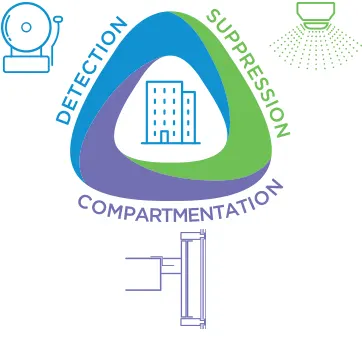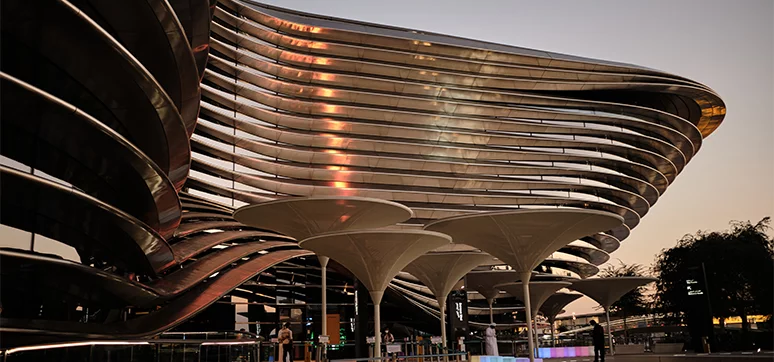According to you, what should be the approach for a solid fire-safe design considering the materials, design and technologies?
Life safety should sit at the heart of any construction project and be a high priority for all stakeholders. Everyone needs to understand how their roles and responsibilities affect delivery of the fire safety strategy.
Ensuring a fire-safe design starts at the pre-design stage as even the earliest decisions can impact on how fire safety standards can be achieved. Taking a ‘fire-safety first’ approach to the building envelope and carefully considering how passive fire protection systems will be integrated into a construction— alongside any active technologies— is key. It is of course vital to ensure the solutions you choose are appropriate for the intended design, including checking if they are properly tested and certified to verify performance.

Whole building design’ and ‘system’ approaches are also crucial. Whilst the standalone performance of individual materials, products, and technologies influence overall performance, understanding the risks associated with how they interface and interact with one another is key to ensuring the fire safety of the whole project. A good solid design should also highlight any practical difficulties that might result in poor installation, which can put the entire fire safety strategy at risk. Manufacturers know their products and have first-hand experience in overcoming challenges, so can provide the right level of support if you engage with them in advance.
What are the active and passive fire protection systems/measures used in projects?
Active and passive fire protection have different roles to play in managing fire risk, and we’d always recommend both are used as part of a comprehensive ‘balanced’ approach comprising detection, suppression and compartmentation. Passive fire protection is built into the building structure and services and works by containing and preventing the spread of fire, heat, and smoke to areas of manageable risk using fire-resistant building materials and gap-filling measures— known as compartmentation. This is achieved with products such as cavity barriers, firestops, fire and smoke dampers, fire-resistant walls or floors, and more. These measures help to protect escape and rescue routes and limit fire damage to the property.
These can be used alongside active systems, such as visual image detection (VID) technologies, fire extinguishers, visual/audio alarms, emergency lighting, smoke ventilation systems, and water mist suppression. These are systems that require some active input to detect, alert, stop or contain the fire.
This holistic, integrated approach means that safety is not reliant on a single factor, increasing the likelihood of successfully maximising life safety by maintaining the stability of a building for a reasonable period, limiting a person’s exposure to fire and smoke and inhibiting fire spread.
What are the standard fire tests carried out to understand the behaviour of fire on the façade and fenestration systems?

One product can serve multiple applications and should be tested to standards that are specific to the designated application to ensure it meets the necessary fire performance. Materials, products, and systems are tested to determine what kind of reaction they have to fire and to what extent they could contribute to it. EN 13501-1 is the harmonized European standard that provides a reaction to fire classification using the results from several tests including EN 13823, ISO 11925-2, ISO 1182 and ISO 1716. Products are classified into Euroclasses. Classes A1 and A2 are considered non-combustible, and B to F are rated as combustible in ascending order.
The ability of passive fire protection solutions to prevent the passage of flames, smoke and toxic gases, and heat transmission for a specified period is determined by resistance to fire testing. There are different tests for evaluating the performance of products that provide compartmentation, all of which differ in scope and methodology. The appropriateness of the test method should always be considered against the real-world demands of end-use applications and tests that emulate real fire conditions can provide a more accurate assessment of in-application performance.
ISO 834 and ASTM E119 subjects test specimens to standard fire exposure conditions. For curtain wall perimeter firestops in a curtain wall assembly, ASTM E 2307-20 and EN 1364-4 are the most used test standards, with both including provision for simulating expansion and contraction of the perimeter joint by subjecting the test construction to movement cycling before fire exposure to simulate seismic activity, wind sway and thermal loading. This is crucial as the firestop must be able to withstand the constant inward and outward movement of the façade and floor slab without degrading during their in-service life.
For ventilated facade types, there are also large-scale system tests that look at the performance of the system as a whole. The two main test standards are NFPA 285 and BS 8414.
How do you ensure that the products recommended/used on the facades/ fenestrations are tested for resistance to fire?

Like any building solutions, passive fire protection products and systems should be fit for purpose and capable of achieving the desired level of performance for your project. This is demonstrated through testing using appropriate test standards. Clear and precise product data should be openly available to help assess their suitability, including genuine and accurate fire resistance test certificates. Taking the time to scrutinise the detail to verify performance claims is important to ensure decisions are appropriately informed.
Furthermore, checking to see if these tests have been third-party certified by an accredited organisation is a very important step for ensuring confidence in the performance and consistency of the products. Gaining certification is a rigorous process, usually involving reviewing product test data against relevant standards and requirements, and submitting product samples for analysis and as comparative samples. Maintaining third-party certification is even more arduous than gaining it, with ongoing surveillance activities including unplanned factory visits and audits where certification will be withdrawn, and re-testing required if any significant changes are observed.
Tell us about the latest trends and technologies and materials which make a façade fire safe?
A key trend is the specification of fire-stopping products and systems that are purposefully engineered for curtain walling. Safing that uses standard stonewool is resistant to lateral compression and the continual movement of the curtain wall can result in the bonding between the fibres breaking down, causing gaps between the product and the façade or floor slab.
Meanwhile, engineered perimeter firestops with a ‘pre-compressed’ vertical fibre (Lamella) orientation are highly compressible laterally. This means that the fibres do not deteriorate when subjected to movement over the life of the building. In the event of a fire, the compression fit is maintained for the duration of the required fire resistance period.
Another growing trend is adopting a ‘system’ approach for protected spandrels in curtain wall systems. This is even mandatory in some regions. This involves the use of a non-combustible stonewool fire barrier board that shields both the spandrel panel and the mullions in the spandrel zone that has been tested as a system in conjunction with the perimeter firestop.
Finally, verifying installation quality is becoming increasingly key as the spotlight on accountability for building safety and liability for when things go awry intensifies. Installation must be undertaken by competent and knowledgeable contractors who are willing to undergo training and regular auditing.
However, since firestops are concealed, it can be difficult for building safety assessors to identify non-compliant installations without having to conduct ‘destructive testing’. Digital tools—such as the Siderise Inspection App—allow users to capture images using their smartphone or tablet as each area/element is being installed. A comprehensive report is produced, which is reviewed offsite by specialists to ensure the installation meets strict criteria. The final report can be included in handover documentation, providing a clear record of exactly what’s in the building and how it was installed.














